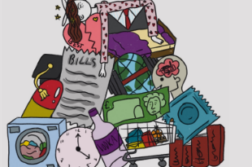Over the past year, there has been an abundance of fashion trends – from flared trousers making a comeback, to the more seasonal puffer jackets. These passing fads have been fulfilled by the rise in fast fashion brands.
What is ‘fast fashion’? It is a term used to describe how brands capitalise on current trends by allowing mainstream consumers to purchase trendy clothes at an affordable price. It’s a win-win for consumers and big-name companies – right? Although it may seem like a good thing, fast fashion is very harmful, for both the environment and workers.
Out of all of the Earth’s polluting industries, fast fashion is placed second in terms of emissions, just below oil, showing the extent of its detrimental nature. The UN has highlighted the horrifying fact that 20% of global wastewater and 10% of global carbon emissions are produced by the fashion industry.
As well as cheap toxic dyes and materials being used which can pollute local environments and oceans, there is huge waste due to consumers throwing away clothes as soon as they are not in trend anymore. Most production workers are also grossly mistreated, with 80% of them being women, and only 2% earning a living wage.
The trend of fast fashion is definitely not new, but it has increased in popularity over the past year. It has been hard to avoid fast fashion brands promoting large discounts on their sites, particularly over the first lockdown in the spring. These brands were evidently profiting from us being inside and spending our days online, trying to make people aim to solve their boredom by buying under-priced clothing.
Don’t get me wrong, I love shopping, but we cannot ignore how harmful fast fashion is. Yes, it’s nice to refresh our wardrobes as the seasons and trends change, but this is outweighed by the horrible treatment of workers within the garment industry, and the detrimental effects on the environment. A recent example of this was the Pretty Little Thing Black Friday sale, when the brand offered deals of up to 99% off, with some garments costing less than 10p. It goes without saying that this was an unreasonably low price point, which makes you wonder how the brand can afford to flog their goods for such low prices.
It’s unlikely that the trend of fast fashion will die down anytime soon. But it’s worth noting the more admirable alternatives to getting your dosage of retail therapy. For instance, second-hand shopping, whether online or in charity shops, is growing in popularity. Not only does it remove consumers from fast fashion, but it’s also a way of bagging genuine, vintage pieces. This is especially topical, with recent trends harking back to fashion from previous eras, such as the bold colours and practicality of 80s fashion. Whilst fast fashion brands are aiming to replicate these vintage fashion trends, nothing can beat a genuine, good-quality piece found in a charity shop.
You can also donate or sell your old, unwanted clothes, which would decrease the waste produced by fast fashion consumption. According to the European Parliament, on average, Zara puts out 24 collections per year, making people more likely to feel the incentive to purchase more clothes in order to fit in with the latest trends. Rather than doing this, we should instead think of what we already have in our wardrobe, and make use of these clothes.
According to TRAID, around 23% of Londoner’s clothes are unworn. This is an incentive to make us shop mindfully and consider the consequences of our need to follow fashion trends. Fast fashion is a harmful trend that needs to be stopped.




